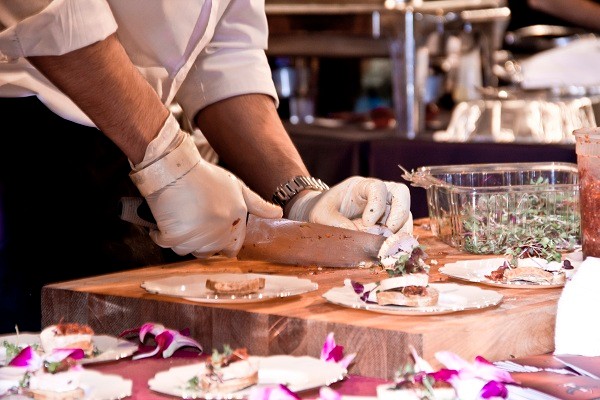At 8th Kosher Food & Wine Expo, it’s all in Good Taste
Beyond the tables of neatly stacked wine glasses, the soft stream of reds and whites became subtly audible as the crimson glow of another wintry sunset faded behind Pier 60 at Chelsea Piers in Manhattan.
In its eighth year, the Kosher Food & Wine Experience has again surpassed even the expectations of the event’s organizers, who have been challenged to keep up with its demand and popularity.
“The first year, we had 350 people and half of the tickets were given away,” quipped Jay Buchsbaum, VP Marketing for Royal Wine Corp, the event’s organizer. “Now we’re sold out in advance — with over 1,600 people!”
What started as a means towards enabling consumers and retailers to taste different kosher wines, especially new releases, has morphed into a premier tasting event, featuring a wide representation of wines from all around the world. Just as significant has been the evolution of food tastings taking a more pronounced role in the event, with top kosher restaurants and caterers from the tri-state area presenting signature samplings, a far cry from the small, light hors d’oeuvres offered at the original Experience.
Though the event has changed over the years — this year’s, on Feb. 24, featured an annexed dessert lounge on a docked yacht — the goal has remained the same: “To expand horizons of existing consumers, to expand the palate of the consumers,” stated Buchsbaum.
When asked if he noticed any change in the guests attending the event, the answer was a resounding “yes,” noting how much more informed the average patron was compared to earlier years.
“Today’s guests are more informed about food, more informed about wine and more knowledgeable about what they are interested in tasting,” he said. They are coming not only to taste, but to learn, experience, and understand modern trends and how to employ them in their own homes.
Long gone are the days when kosher wine was limited to the sweet, sacramental kind (so thick a spoon could stand up in it — and yes, my father drank four full cups on Passover). California, Spain, France, Italy, New Zealand and most prolifically Israel, among other regions, presented an array of fantastic wines, many with sophisticated, aromatic blends derived from both large vineyards and small family-owned labels.
Covenant, out of the Napa Valley, has presented consistently good wines each year — of note, their Lavan (Chardonnay) and Red C (Cabernet).
With so many Israeli wines (and a wide price range) to choose from, my top picks of the evening are the Castel Petit Castel, a fruity table wine with a blend of Merlot, Cabernet and Petit Verdot; Grand Vin, their premier wine is rich, oaky (aged for 22 months in new French oak) and deeply fruity, a great choice for special occasions.
Psagot’s Single Vineyard was another favorite, slightly peppery and a great complement for meats. New on the scene and lesser known is Pacifica, the first dedicated kosher winery in the Oregon/Washington region. A small winery, Pacifica produces only 2000 cases per year, but winemaker Phillip Jones (formerly of Goose Bay Winery) takes great pleasure in crafting their wine, his favorite being Meritage, an interesting blend of four grapes (Cab, Merlot, Petit Verdot and Malbec) and aged for 12 months in medium French oak. Spanish wine such as Capçanes Peraj Ha’Abib captures a spicy fruitiness; more mellow is their Petita Rosat, a delicious and fragrant Rose wine.
Even if wine is not your passion, food tastings provided an insight into the newest trends in kosher cooking and fine cuisine. Chefs at many of today’s best kosher restaurants are classically trained and skilled, applying knowledge of techniques traditionally used in non-kosher food to the kosher table. The result: an explosion of flavors and textures carefully layered into so many signature dishes.
When kosher lamb bacon appeared on the scene a few years back, it was innovative and revolutionary; at KFWE 2014, the development of kosher charcuterie (cured meats) was apparent and unmistakable.
Executive Chef David Kolotkin of The Prime Grill acknowledged this as “trend of the year,” and presented some of their house-made charcuterie, a salumi (aged nine months) that was spicy-smoky and deeply satisfying all by itself.
Incorporating it into the dish, Chagall Bistro, a new French bistro in Brooklyn’s Park Slope, featured cured duck pastrami with a fruit relish and balsamic-ginger emulsion.
Wolf & Lamb’s Pastrami Wrapped Marinated Apricots with ginger glaze and pineapple chutney was a blend of sweet, pungent and smoky, perhaps the most memorable dish of the night, despite its simplicity.
Asked about the biggest trend in kosher food and wine, Buchsbaum cracked a smile and replied, “Kosher consumers are ready to spend the money on quality.” When quality matters, it’s clear that the future of kosher choices are on the rise.
Naomi Ross is a kosher cooking instructor and food writer and can be reached at cookingconcepts@gmail.com.

 47.0°,
Fair
47.0°,
Fair 







